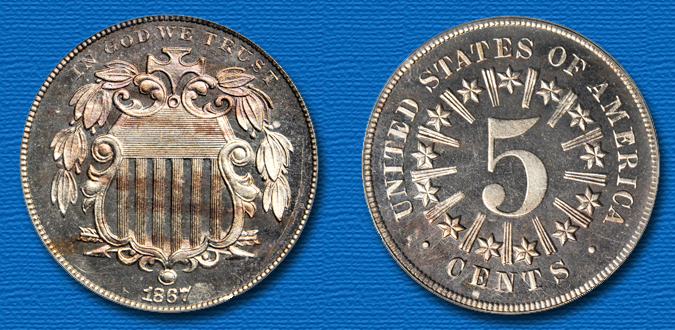
Introduced in 1866, the copper-nickel five-cent coin has remained an integral part of our nation’s coinage ever since. This coin traces its roots to the suspension of specie payments that occurred during the Civil War. Silver and gold coins disappeared from circulation soon after the conflict began in 1861. Initially the silver half dime was replaced with five-cent Postage Currency and later, Fractional Currency notes, which circulated well after General Robert E. Lee’s surrender at Appomattox, Virginia in 1865 as specie payments remained in suspension after the end of the war. In order to provide an alternative to this currency, Congress followed the three-cent copper-nickel coins of 1865 with similar five-cent copper-nickel coins authorized by the Act of May 16, 1866.
Both the three-cent and the five-cent copper-nickel coins were struck on planchets composed of 75% copper blended with 25% nickel. The initial proposed weight of the new five-cent coin was to be around 30 grains, or about one and a half times the existing (but not currently circulating) silver half dime. As discussions progressed, Joseph Wharton, the owner of most of the Western Hemisphere’s nickel mines, was able to convince Congress to increase the weight to 77 grains, thereby requiring more nickel for each coin produced.
Mint Engraver James Barton Longacre designed the new coin, with the obverse displaying a large central shield with arrows crossed at its base, draped in a hanging wreath with a broad cross above. The date is below and IN GOD WE TRUST is in small letters at the top. For the reverse a large numeral 5 is central, surrounded by 13 small stars and 13 glory rays alternating in sequence. Above the 5 is UNITED STATES OF AMERICA with CENTS below.
The rays on the reverse proved to be problematic as the copper-nickel planchet was very hard and difficult to fully strike this design. The alloy was so hard, in fact, that the dies soon developed cracks and did not last long. When reports of these issues reached Treasury Secretary McCulloch, he promptly ordered the rays be removed on January 21, 1867, and production was halted until new dies could be created; production of the new style began on February 1, 1867.
Research by R.W. Julian found that Chief Coiner Snowden delayed striking 1867 With Rays Proof five-cent pieces for inclusion in annual Proof sets. However, it is entirely likely that Mint Director Henry Linderman had these 1867 With Rays Proofs struck clandestinely to be distributed to his collector friends, as was common during this era at the Philadelphia Mint. At least four different die marriages exist of this rare coin in Proof, which seems to point to multiple strikings, perhaps after the designs had been replaced, although there is no evidence beyond the coins that exist today.
The 1867 Rays five-cent coin in Proof remains one of the key issues to the series. This issue is the rarest of the Proof Shield nickel designs, and has been sought after by collectors for generations, especially so when found at the Gem Proof grade level.
In our 2014 New York Americana Sale in February, Stack’s Bowers Galleries is pleased to present an incredible Proof 1867 Rays five-cent piece. The exquisite surfaces exhibit a few horizontal streaks of pinkish rose iridescence and considerable brilliance. A marked cameo finish goes unmentioned on the old style PCGS insert. This is an undeniably beautiful example of a rare and highly desirable issue. The original mintage has always been estimated to be quite low, but more recent research leads us to believe fewer than 100 pieces were struck. Today it is believed by PCGS that about 60 individual examples exist, the present near the top of those that survive in terms of condition and eye appeal.





